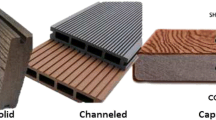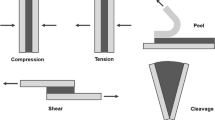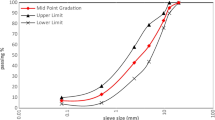Abstract
Thermoplastic elastomers, such as styrene–butadiene–styrene (SBS), significantly enhance the properties of asphalt binders. This study first highlights the drawbacks of binder modification using chemically grafted polyethylene (g-PE) and then demonstrates the process by which g-PE can be used in combination with SBS. The important role of chemical grafting, sulphur content, and melt flow index (MFI) value in obtaining practically usable ‘g-PE/SBS’ modified binders have been illustrated. The results show that ungrafted and g-PE produces modified binders with highly inferior properties, and the polymers phase separate from the binder within few hours of preparation. % Elastic recovery of the ungrafted and g-PE modified binders was < 30%, and the softening point was 10 to 25 °C lower than SBS modified binders. Modification using the ‘50/50’ g-PE/SBS blend also resulted in inferior modified binders. On the other hand, the ‘25/75’ g-PE/SBS blend resulted in modified binders with properties similar to SBS modified binders. Chemical grafting, sulphur content of 0.21 wt.%, and melt flow index value > 2 are the essential factors that resulted in acceptable ‘25/75’ g-PE/SBS modified binders. Cost analysis shows that the use of g-PE can reduce the overall cost of asphalt pavement. The strategy illustrated in this study can be adopted for low-cost polymers and the effective utilization of waste plastics.












Similar content being viewed by others
Abbreviations
- TP:
-
Thermoplastic
- PE:
-
Polyethylene
- SBS:
-
Styrene–butadiene–styrene
- MA-PE1 :
-
Maleic anhydride functionalized polyethylene (MFI value of 0.5)
- MA-PE2 :
-
Maleic anhydride functionalized polyethylene (MFI value of 2)
- GM-PE1 :
-
Glycidyl methacrylate functionalized polyethylene (MFI value of 0.8)
- GM-PE2 :
-
Glycidyl methacrylate functionalized polyethylene (MFI value of 3.5)
- MFI:
-
Melt flow index
- SP:
-
Softening point
- ∆SP:
-
Difference in the softening point between top and bottom section of the tube
- PMB:
-
Polymer-modified binder
- MB:
-
Modified binder
- TP-MB:
-
Thermoplastic modified binder
- SBS-MB:
-
SBS modified binder
- 0.14S:
-
0.14 wt.% sulphur
References
Naoual EA, Rachid H, Jalila EA, Mehdi EB, Ahmed E (2020) Synthesis rheological and thermal studies of epoxy polymer and its composite. Chem Data Collec 30:100584
Naoual EA, Rachid H, Jalila EA, Mehdi EB, Abderrahim E, Ahmed E, Mohamed R (2021) One-pot synthesis of tri-functional epoxy resin and its nanocomposite: Investigation of thermal and rheological properties. Bio-inter Rese Appl Chem 11(4):12403–12413
Rachid H, Ahmed E (2020) Rheological behavior of three polymers and their hybrid composites (TGEEBA/MDA/PN), (HGEMDA/MDA/PN) and (NGHPBAE/MDA/PN). J King Saud Univ Sci 32(1):235–244
Rachid H, Omar D, Mohamed B, Mehdi EB, Mohammed A, Abderrahim EB, Ahmed E (2019) Investigation of structure and rheological behavior of a new epoxy polymer pentaglycidyl ether pentabisphenol A of phosphorus and of its composite with natural phosphate. SN Appl Scie 1:869
Rachid H, Mohamed B, Mehdi EB, Abderrahim EB, Ahmed EH (2019) Synthesis characterization rheological and morphological study of a new epoxy resin pentaglycidyl ether pentaphenoxy of phosphorus and their composite (PGEPPP/MDA/PN). Poly Bulle 76:4859–4878
Atiqa B, Rachid H, Ahmed E (2020) Evaluation of mechanical compressive strength of cementitious matrix with 12% of IER formulated by modified polymer (NEPS) at different percentages. Sci Rep 10:2461
Lakshmi KR, Rehman A, Mabrouk O, Senthil KK, Ahmed A, Eyad M (2021) Influence of polymer structure and amount on microstructure and properties of polyethylene-modified asphalt binders. Mater and Struct 54:91
Priyansh S, Aravind KS (2018) Effect of aging level on viscoelastic properties of asphalt binder containing waste polyethylene. Inter J Sust Eng 19397038:1474398
Gonzalez E, Liliana MBC, Hugo MRDS, Loic H (2016) Rheological characterization of EVA and HDPE polymer-modified bitumens under large deformation at 20 °C. Const Build Mater 112:756–764
Tian X, Xiang C, Jianhui X, Wenqiang C, Xinyue H, and Youbing L (2021) Properties of bitumen modified by polyethylene and polyethylene glycol with different molecular weights. Inter J Pave Eng 1-8
Nejad FM, Azarhoosh A, Hossein HG (2014) Effect of high-density polyethylene on the fatigue and rutting performance of hot mix asphalt – a laboratory study. Road Mater Pave Desi 15(3):746–756
Moatasim A, Cheng PF, Al-Hadidy, (2011) Laboratory evaluation of HMA with high-density polyethylene as a modifier. Const Build Mater 25:2764–2770
Kalantar ZN, Karim MR, Mahrez A (2012) A review of using waste and virgin polymer in the pavement. Const Build Mater 33:55–62
Luca D, Michele L (2021) Variation of internal structure and performance of polyethylene and polypropylene-modified bitumen during the blending process. J Appl Poly Scie 138(14):e50142
Fawcett AH, McNally T (2003) Polystyrene and asphaltene micelles within blends with bitumen of an SBS block copolymer and styrene and butadiene homopolymers. Collo and Poly Scie 281:203–213
Mohamed N, Ramlochan D, Maharaj R (2017) Rutting and fatigue cracking susceptibility of polystyrene modified asphalt. Amer J Appl Scie 14:583–591
Behl GS, Kumar G (2014) A sustainable approach: utilization of waste PVC in asphalting of roads. Const and Build Mater 54:113–117
Estabraq NE and Alaa HA (2020) Effects of polyvinyl chloride (PVC), styrene-butadiene-styrene (SBS) and aggregate gradation on permanent deformation of asphalt concrete pavement. In: 3rd International Conference on Engineering Sciences, Mater Sci Eng 671:012093
Rabindra K, Gupta AA, Badonib RP, Bhatnagarac AK (2013) Poly(ethylene terephthalate) waste-derived chemicals as an anti-stripping additive for bitumen-An environment-friendly approach for disposal of environmentally hazardous material. Poly Degr and Stab 98:2592–2601
Taher BM, Mehrtash S, Mohamed RK (2014) Evaluation of permanent deformation characteristics of unmodified and polyethylene terephthalate modified asphalt mixtures using dynamic creep test. Mater and Desig 53:317–324
Gonzalez O, Munoza ME, Santamarıiaa A, Garcia MM, Navarro FJ, Partal P (2004) Rheology and stability of bitumen/EVA blends. Eurp Poly J 40:2365–2372
Garci MM, Partal P, Navarro FJ, Martinez FB, Gallegos C (2004) Linear viscoelasticity of recycled EVA-modified bitumens. Ener & Fuel 18:357–364
Ziari HEN, Amir A, Omid F (2019) The effect of EAF dust and waste PVC on moisture sensitivity, rutting resistance, and fatigue performance of asphalt binders and mixtures. Const and Build Mater 203:188–200
Claudia R, Antonio AC, Levgenii L, Moises GM (2016) Linear and non-linear viscoelastic behavior of SBS and LDPE modified bituminous mastics. Const and Build Mater 123:464–472
Ming L, Xue X, Weiyu F, Hao W (2019) Phase behavior and hot storage characteristics of asphalt modified with various polyethylene: Experimental and numerical characterizations. Const Build Mater 203:608–620
Liliana MBC, Hugo MRD, Silva JP, Joel RM, Oliveira, (2019) Using waste polymers as a reliable alternative for asphalt binder modification – Performance and morphological assessment. Const Build Mater 198:237–244
Pawan K, Satish C, Sunil B (2006) Strength characteristics of polymer modified mixes. Inter J Pav Eng 7(1):63–71
Giovanni P, Jiri S, Dario B, Ludovit Z (2006) Relation between polymer architecture and nonlinear viscoelastic behavior of modified asphalts. Curr Opin Collo & Inter Scie 11:230–245
Giovanni P, Sara F, Filippo M, George S (2015) A review of the fundamentals of polymer-modified asphalts: asphalt/ polymer interactions and principles of compatibility. Adv Collo Inter Scie 224:72–112
Rachid H, Atiqa B, Omar D, Abderrahim EB, Mohamed R, Ahmed E (2020) Rheological properties of composite polymers and hybrid nanocomposites. Heliyon 6(6):e04187
Maria AV, Miguel AV, Antonio SS, Octavio M (2013) Asphalt/polyethylene blends: rheological properties, microstructure and viscosity modelling. Const and Build Mater 45:243–250
Jiusu L, Wenke J, Wen Y (2014) Effect of polyethylene grafted with maleic anhydride on asphalt properties. J Perf Const Faci 28(4):04014012
Pei-Hung Y, Yu-Hsun N, Jean-Hong C, Wei-Chyum C (2005) Thermal and rheological properties of maleated polypropylene modified asphalt. Poly Eng Sci 45(5):1152–1158
Wen-qian L, Jiu-cun C (2011) Preparation and properties of bitumen modified by EVA graft copolymer. Const Build Mater 25:1830–1835
Behnood A, Mahsa MG (2019) Morphology, rheology, and physical properties of polymer-modified asphalt binders. Eur Poly J 112:766–791
Jeffrey JC, David GR, and Neil RG (2015) Grafted polyethylene: united states patent Application Publication. US 2015/0376409 A1
Nicole MGF, Joost NHR, Bas D (2013) Bruin synthesis of functional ‘polyolefins’: state of the art and remaining challenges. Chem Socie Rev 42:5809–5832
Rongrong Q, Junling Q, Chixing Z (2003) Modification of acrylonitrile–butadiene–styrene terpolymer by grafting with maleic anhydride in the melt. I. Preparation and characterization. J Appl Poly Scie 90:1249–1254
Li J, Zhang Y, Zhang Y (2008) The research of GMA-g-LDPE modified qinhuangdao bitumen. Const and Build Mater 22:1067–1073
Sengoz B, Isıkyakar G (2008) Evaluation of the properties and microstructure of SBS and EVA polymer modified bitumen. Const and Build Mater 22(9):1897–1905
Yogesh K, Sumit KS, Deepa O, Praveen K, Paritosh M, Sham SR (2020) Effect of molecular structure and concentration of styrene-butadiene polymer on upper service temperature rheological properties of modified binders. Const Build Mater 249:118790
Guangtao G, Yong Z, Yinxi Z, Kang S, Yongzhong F (2002) Improved Storage Stability of LDPE/SBS Blends Modified Asphalts. Poly Poly Comp 10(3):229–236
Tian X, Longmei Z, Jianhui X, Yaping Q (2018) Rheology and thermal stability of polymer modified bitumen with coexistence of amorphous phase and crystalline phase. Const Build Mater 178:272–279
Aravind KS, Uma DR, Pramod KJ (2017) Effect of HDPEH polymer on viscoelastic properties of SBS modified asphalt. Const Build Mater 136:230–236
Abolghasem Y, Sara P (2012) Optimization of Asphalt Binder Modified with PP/SBS/nanoclay nanocomposite using taguchi method. Int J Mater Metall Eng 6(7):532–536
Hailong J, Guangtao G, Yong Z, Yinxi Z (2002) Improved properties of polystyrene-modified asphalt through dynamic vulcanization. Poly Test 21:633–640
Jing L, Meizhao H, Yaseen M, Yu LSY, Shaochan D, Wenqian H, Zhenxia Z (2018) Comparative analysis, road performance and mechanism of modification of polystyrene graphene nanoplatelets (PS-GNPs) and octadecyl amine graphene nanoplatelets (ODA-GNPs) modified SBS incorporated asphalt binders. Const Build Mater 193:501–517
Haiyan Z, Xiaowei W, Dongwei C, Yanjun Z, Min H (2013) Effect of linear low density-polyethylene grafted with maleic anhydride (LLDPE-g-MAH) on properties of high density-polyethylene/styrene–butadiene–styrene (HDPE/SBS) modified asphalt. Const Build Mater 47:192–198
Ajay KM, Arun G, Abhishek M (2021) Investigation of rheological and performance characteristics of oxidized polyethylene polymer blended with SBS modified bitumen. Mater Sci Eng 1017(1):012030
Ilya BJ, Filippo G (2020) Effect of different vinyl-acetate contents in hybrid SBS-EVA modified bitumen. Const Build Mater 262:120574
Chen JS, Liao MC, Lin CH (2003) Determination of polymer content in modified bitumen. Mater and Struct 36:594–598
SkI S, Sumit KS, Ransinchung GD, RN, and Sham SR, (2021) Effect of property deterioration in SBS modified binders during storage on the performance of asphalt mix. Const Build Mater 272:121644
Han S, Dong YN, Ya ML, De C, Deng WL (2014) Analysis of the impact of the type and content of SBS on the performance of the modified asphalt mixture. Adv Mater Res 919–921:1079–1084
Sumit KS, Yogesh K, Sham SR (2018) Thermal degradation of SBS in bitumen during storage: influence of temperature, SBS concentration, polymer type and base bitumen. Poly Degr Stab 147:64–75
Sengoz B, Topal A, Isikyakar G (2009) Morphology and image analysis of polymer modified bitumens. Const Build Mater 23:1986–1992
Kou C, Peng X, Aihong K, Peter M (2019) Protocol for the morphology analysis of SBS polymer modified bitumen images obtained by using fluorescent microscopy. Int J Pave Eng 20:585–591
Motahareh M, Akram T, Mir KRA, Mohammad R (2016) Effect of nanoclay on the morphology of polyethylene modified bitumen. Const Build Mater 116:245–251
Chen JS, Huang CC (2007) Fundamental characterization of SBS-modified asphalt mixed with sulfur. J Appl Poly Scie 103:2817–2825
Ming L, Xue X, Weiyu F, Hao W (2017) Effects of polymerized sulfur on rheological properties, morphology and stability of SBS modified asphalt. Const and Build Mate 150:860–871
Rishichem Distributors Private Limited. https://rishichem.com/products.htmls
Pluss Advanced Technologies. http://www.pluss.co.in/product-range.php
Acknowledgements
This work is supported by a research grant from SERB, India (ECR/2016/001427).
Author information
Authors and Affiliations
Contributions
The authors confirm contribution to the paper as follows: Concept and study were contributed by Akanksha Pandey and Sham S. Ravindrnath; Sample collection and testing were contributed by Akanksha Pandey and Alok Sharma; Analysis and interpretation of results were contributed by Akanksha Pandey and Sham S. Ravindrnath; Draft manuscript preparationwas contributed by Akanksha Pandey and Sham S. Ravindrnath.
Corresponding author
Ethics declarations
Conflict of Interest
The authors declare that they have no known competing financial interests or personal relationships that could have appeared to influence the work reported in this paper.
Additional information
Publisher's Note
Springer Nature remains neutral with regard to jurisdictional claims in published maps and institutional affiliations.
Appendices
Appendix
FT-IR analysis
(Peak at 1767 cm−1 is noticed for carbonyl group in g-PE compare to ungrafted PE. Along with that, GMA g-PE exhibited peak at 845 cm−1 for epoxy group also.) The results of the other two g-PE were similar and hence not presented to avoid redundancy (See Fig. 13).
TGA analysis
(MA-PE exhibited higher thermal stability compared to PE and GM-PE polymer. The divergence in thermal stability might be due to the type of functional group present in the polymer.) (See Fig. 14).
XRD analysis
(XRD spectrum depicts the reduction in crystallinity due to the presence of grafting in the backbone chain compare to the ungrafted PE. The stated observation is made because of the decrease in intensity and broadening of the peak.). (See Fig. 15).
Rights and permissions
About this article
Cite this article
Pandey, A., Sharma, A. & Ravindranath, S.S. Modification of asphalt binder by the blend of chemically grafted thermoplastics and SBS: Influence of blend composition, chemical grafting, sulphur content, and MFI value. Polym. Bull. 79, 7753–7774 (2022). https://doi.org/10.1007/s00289-021-03868-7
Received:
Revised:
Accepted:
Published:
Issue Date:
DOI: https://doi.org/10.1007/s00289-021-03868-7







